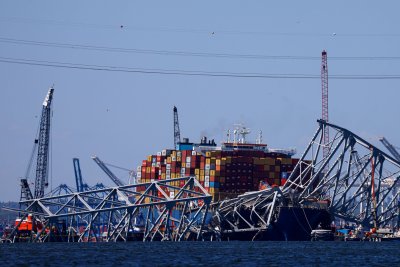
Nov. 18 (UPI) — The National Transportation Safety Board announced Tuesday that an incorrectly labeled wire caused a containership to collide with the Francis Scott Key Bridge in Baltimore last year.
The federal agency released the key finding of its investigation into the catastrophic collision that killed six highway maintenance workers, destroyed a major regional transportation artery and upended trade at one of the country’s busiest ports.
Jennifer Homendy, the board’s chair, said, “This tragedy should’ve never occurred” in her opening remarks at a public meeting.
“As with all accidents we investigate, this was preventable,” she said.
Federal investigators determined that the Dali containership crashed into the bridge after losing electricity. The cause of the blackout was a loose signal wire connection to a terminal block that investigators traced back to improperly installed wire-label banding.
The Dali lost its propulsion and steering, and the crew had little time to recover before the ship struck a southern pier that was supporting the bridge’s central span, investigators concluded. As a result, a “substantial portion” of the bridge collapsed into the Patapsco River.
Additionally, the investigation also faulted Maryland officials for not assessing the bridge earlier for potential vulnerabilities to collisions with ships. The “lack of effective and immediate communications” also contributed to the deaths of the highway workers, investigators found.
The Francis Scott Key Bridge was constructed before 1994, when bridges were mandated to meet safety criteria to reduce the risk of a collapse. State officials have since announced plans for a replacement bridge over the Patapsco River, which is estimated to cost at least $1.7 billion and be twice as high as the Francis Scott Key Bridge.
The city of Baltimore filed a lawsuit against Grace Ocean Private and Synergy Marine, the owners of the Dali, arguing that the 985-foot container ship was “a clearly unseaworthy vessel” and the companies “were grossly and potentially criminally negligent.”